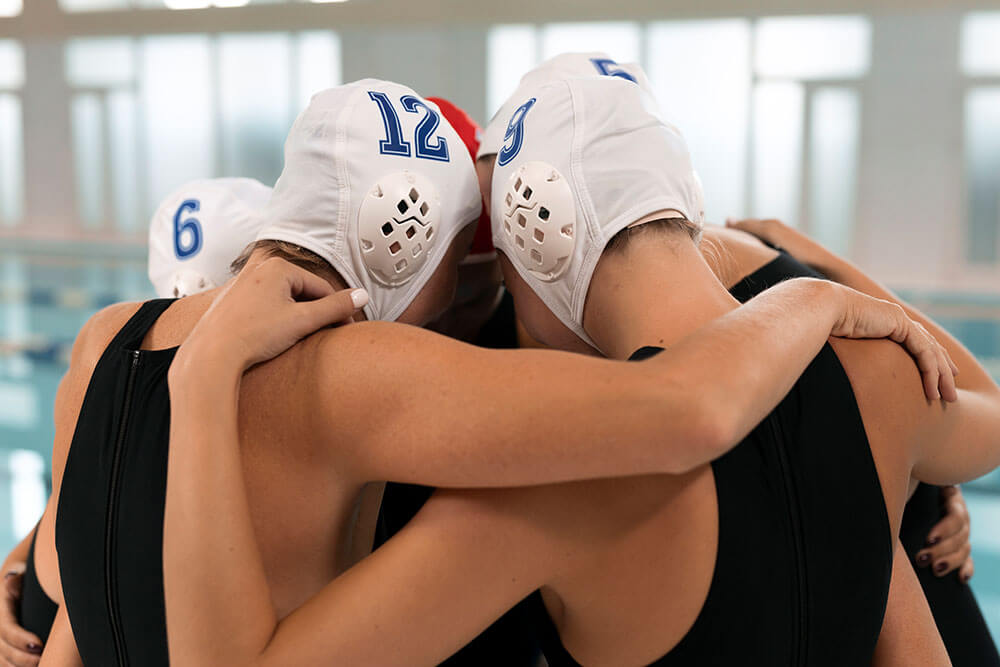The future of sports
Gender Shift & Inklusion
Anja Kirig & Marcel Aberle
Futurologists and trend researchers Anja Kirig and Marcel Aberle have conducted a survey with experts from the world of sports and sports facilities to look at nothing more and nothing less than the future of sports, on many levels.
What does the gender shift megatrend mean for fan culture?
The gender shift megatrend does not stop at fan culture in sport. The sports fan landscape has diversified. Accurate data on the growth of female and LGBT* sports fans over the last twenty years is hard to find. However, several studies suggest that a more accessible, consumerorientated fan culture and social interaction opportunities have opened new opportunities for fans of all genders and sexual orientations.
Fans of all genders are beginning to challenge gender stereotypes in sport. The assumption that women are disinterested or ignorant in sport is being challenged by the emergence of dedicated female* fans, analysts, and commentators. This development is helping to break down outdated gender stereotypes in sport.
The demand for greater representation of women’s sport in the sports media has also led to an increase in female sports journalists and more intensive reporting on women’s sport. Events such as women’s football and the Tour de France for women are receiving more attention as a result.
Incidentally, this has a direct impact on the number of women who then (want to) practise the sport themselves. The debate about equal pay in sport, particularly in football, also illustrates the change in social expectations regarding gender equality. Fans are actively shaping and driving this discourse. Groups such as Arsenal FC’s Gay Gooners actively campaign against homophobia and promote inclusion in football. These groups help to raise awareness of diversity and inclusion in sports.
Forecast and outlook
Despite the positive developments, there is still a lot of untapped potential. However, the integration of a diverse fan culture requires more proactive measures from sports
organisations, clubs, and associations. A single women’s representative in a club is not enough to realise the full potential of a diverse fan base.
To what extent should the sports facilities be gender-neutral (e.g. changing rooms, showers)? If necessary, what is desired?
In the context of the gender shift megatrend, gender roles and gender identities are being challenged. This development is particularly significant in the context of sport. It is not only many sports that are linked to a binary understanding of gender, whether socially constructed or institutionally anchored due to competitive conditions.
A key approach is to recognise diversity. This is because the younger generation in particular increasingly no longer sees itself exclusively in binary gender categories. Gender-neutral approaches, such as public swimming pools with individual changing rooms and showers, can help people feel comfortable and safe in sports facilities regardless of their gender identity.
The process involves more than just creating gender-neutral spaces. It is about recognising and valuing the diversity of gender identities. Continuous dialogue with the sports community is a necessity. This is the only way to understand the needs of different groups. There is no universal solution, which is why the involvement of users in the design process is so important. Successful initiatives such as the EuroGames show how positive change can be brought about by taking diversity and inclusion into account.
Acceptance of transgender people and non-binary identities in sport remains controversial, and the traditional binary in competition often leads to exclusion. It is therefore important to critically scrutinise existing structures and address where change is possible and necessary in order to promote an inclusive and respectful sporting environment. Raising awareness of gender diversity, non-heteronormative lifestyles and identities remains of central importance.
Forecast and outlook
Possible counterarguments could be that the majority still operate within traditional gender boundaries in the world of sport. However, the question goes beyond the pure aspect of gender
neutrality and gender sensitivity. Rather, the question is whether the principles of diversity and inclusion should be supported.
Mögliche Gegenargumente könnten sein, dass die Mehrheit immer noch innerhalb der traditionellen Geschlechtergrenzen in der Sportwelt agiert.
Die Frage geht jedoch über den reinen Aspekt von Genderneutralität und Gendersensibilität hinaus. Es steht vielmehr zur Diskussion, ob man die Grundsätze der Vielfalt und Integration unterstützen möchte.
Diversity starts where there is acceptance that people are different. Inclusion, on the other hand, begins where heterogeneity is allowed to interact.
It becomes more difficult to answer the question of where diversity and inclusion end. However, the boundaries of these concepts are fluid and evolve with changing social conditions. They could be considered obsolete when injustice, discrimination and exclusion no longer exist — an idealistic goal that can be inherently contradictory, as the decision to achieve it is subjective.
The meanings of diversity and inclusion have changed over time. They always reflect a specific understanding of values. Diversity used to refer mainly to demographic aspects such as origin, gender, religion, and age. Today, these concepts encompass a broader range of characteristics, including sexual orientation, gender identity, socioeconomic status, physical and cognitive processing patterns (neurodiversity) and mental health.
Intersectionality, the recognition of overlapping experiences that shape one’s own identity and self-image, is also considered in the context of diversity. This topic is no longer primarily about including more people from a homogeneous, specific group that was previously not so strongly represented.
Rather, it is important to recognise that there is multiple discrimination, which makes it necessary to create an appropriate environment in which every person truly feels represented as an individual. This process questions established norms, uncovers prejudices and sheds light on unequal power structures.
Points of criticism such as the fear of reverse discrimination or the use of diversity as an end in itself, which could prevent genuine inclusion, are part of the discussion.
Forecast and outlook
The understanding of diversity and inclusion varies depending on the cultural background. In a globalised and interconnected world, however, these concepts are received internationally. Both diversity and inclusion remain controversial issues. Although it is an ongoing process, it does not always move in a linear fashion.
Authors
Anja Kirig
Future and trend research

Marcel Aberle
Megatrends & transformations

Photos
FREEP!K
Do you want more?
Your turn.
Introduce yourself
Your stage
DO YOU WANT TO PUBLISH YOUR PROJECT OR PRODUCT?




